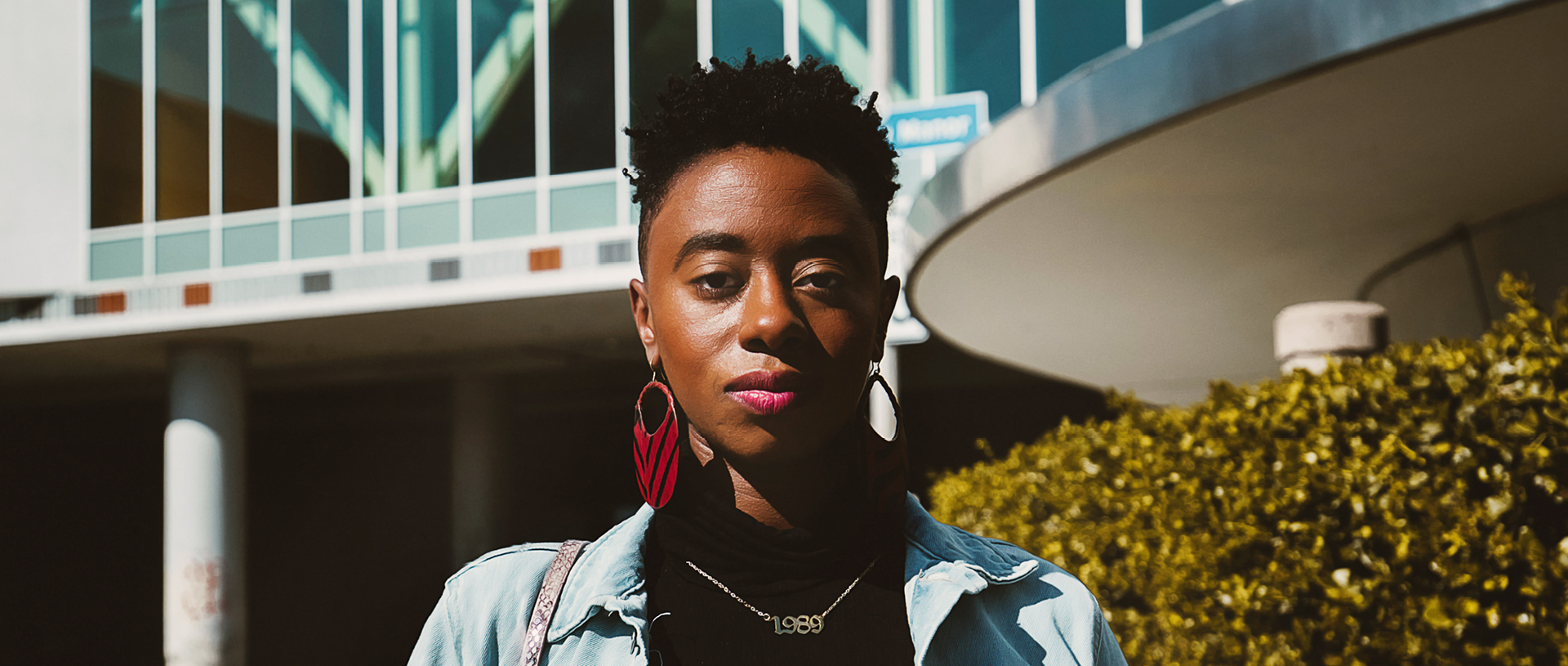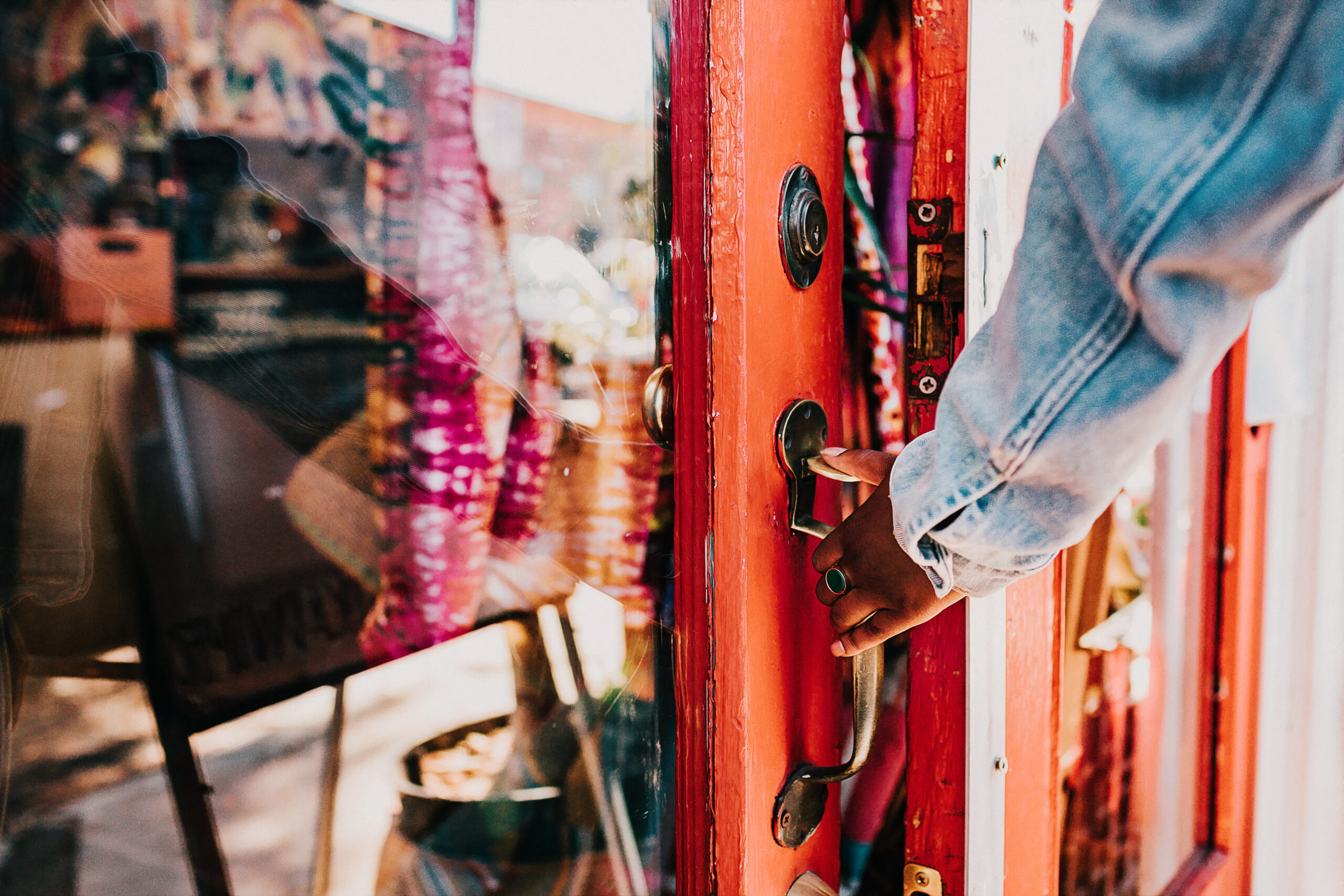
When Amber Height (MAICS ’21) first began her studies at Fuller, she didn’t foresee moving to the Crenshaw neighborhood in South LA after graduation to work on protecting a shopping mall. As she worked toward her degree, she originally planned to seek out farther geographical coordinates and work internationally, specifically somewhere in Africa.
“What would it look like for me to be in Africa to work on projects that protect the bodies of Black women over there?” she asked herself. “What would it look like for me to work to help someone experience dignity abroad?” But as she progressed through her program, more and more international connections and conversations with fellow students from Africa led her to see commonality in their shared experiences. The deep passion Amber had to protect and restore dignity for Black bodies was needed not only in Africa but also as close as her own backyard.
A native of Detroit, she was no stranger to walking too many miles to catch a bus for a dentist visit or a vaccine appointment. Or having to pass through unsafe parts of the city to go to the grocery store. Or wanting stable housing and dignity for Black women. Through her own writing, research, and growing friendships, Amber found a new perspective on her purpose as she realized there was much work to be done here.
By Amber’s final year at Fuller, she knew she wanted to do community work. “God was calling me to make the human experience for Black people something that they could appreciate and something they could enjoy that doesn’t rob them of their own humanity.” Her vision was to see people in their own Black communities with access to dentist offices, grocery stores, entertainment, and shopping—all walkable, liveable, and affordable. “I know God was calling me to help make that happen.”
She found an opportunity to pursue that calling when she learned from a friend about what was happening only 30 minutes away from her in Crenshaw.
Bridging the intersection of West Martin Luther King Jr. Boulevard and Crenshaw Boulevard stands the Baldwin Hills Crenshaw Plaza, a 42-acre two-story indoor mall first established in 1947, making it one of the oldest regional shopping centers in operation in the United States. The “Crenshaw Mall,” as it’s locally known, has been a staple of the historically and predominantly Black community in South Los Angeles for decades. According to Amber, the mall represents everything from a haven for Black-owned businesses to a cultural remnant of Black experiences and memories. On numerous occasions, the mall has proudly hosted the prestigious Pan African Film Festival, the largest international Black film festival in the nation, first held there in 1996 at the since-closed Magic Johnson Theaters.

Chantelle Gibbs is Fuller’s senior events producer.
Karley Carrillo is a creative content producer for Christian Assembly Church in Los Angeles and a freelance photographer. See more of her work at itsmekarley.com.
When Amber Height (MAICS ’21) first began her studies at Fuller, she didn’t foresee moving to the Crenshaw neighborhood in South LA after graduation to work on protecting a shopping mall. As she worked toward her degree, she originally planned to seek out farther geographical coordinates and work internationally, specifically somewhere in Africa.
“What would it look like for me to be in Africa to work on projects that protect the bodies of Black women over there?” she asked herself. “What would it look like for me to work to help someone experience dignity abroad?” But as she progressed through her program, more and more international connections and conversations with fellow students from Africa led her to see commonality in their shared experiences. The deep passion Amber had to protect and restore dignity for Black bodies was needed not only in Africa but also as close as her own backyard.
A native of Detroit, she was no stranger to walking too many miles to catch a bus for a dentist visit or a vaccine appointment. Or having to pass through unsafe parts of the city to go to the grocery store. Or wanting stable housing and dignity for Black women. Through her own writing, research, and growing friendships, Amber found a new perspective on her purpose as she realized there was much work to be done here.
By Amber’s final year at Fuller, she knew she wanted to do community work. “God was calling me to make the human experience for Black people something that they could appreciate and something they could enjoy that doesn’t rob them of their own humanity.” Her vision was to see people in their own Black communities with access to dentist offices, grocery stores, entertainment, and shopping—all walkable, liveable, and affordable. “I know God was calling me to help make that happen.”
She found an opportunity to pursue that calling when she learned from a friend about what was happening only 30 minutes away from her in Crenshaw.
Bridging the intersection of West Martin Luther King Jr. Boulevard and Crenshaw Boulevard stands the Baldwin Hills Crenshaw Plaza, a 42-acre two-story indoor mall first established in 1947, making it one of the oldest regional shopping centers in operation in the United States. The “Crenshaw Mall,” as it’s locally known, has been a staple of the historically and predominantly Black community in South Los Angeles for decades. According to Amber, the mall represents everything from a haven for Black-owned businesses to a cultural remnant of Black experiences and memories. On numerous occasions, the mall has proudly hosted the prestigious Pan African Film Festival, the largest international Black film festival in the nation, first held there in 1996 at the since-closed Magic Johnson Theaters.
Chantelle Gibbs is Fuller’s senior events producer.
Karley Carrillo is a creative content producer for Christian Assembly Church in Los Angeles and a freelance photographer. See more of her work at itsmekarley.com.


Different equity groups, with their seven-figure bids, vied to buy out the mall several times. Fears of impending gentrification and displacement, along with their own vision for revitalization, galvanized the local Black community and leaders to thwart these bids and put in one of their own. Downtown Crenshaw Rising, known as Downtown Crenshaw for short, began as a grassroots movement bred in opposition to outside investors and a desire to see the mall redeveloped for immediate needs in the Crenshaw neighborhood from the perspectives and voices of those who live there.
Venturing with her friend to one of the Downtown Crenshaw-hosted community events frequently held at the mall, Amber watched the community gather together and heard a vision cast for “what it’s like to have peace and space at our own mall.”
Amber was in. She turned to someone near her and asked if the group was looking for volunteers or interns. Without Amber even knowing that she was speaking with the president of the Downtown Crenshaw board, an emphatically answered “yes” turned into a phone call from the executive director wishing to hire Amber. After commuting from Pasadena to Crenshaw for several months to volunteer, Amber made the move to South Los Angeles right after graduation, half a mile away from the mall, and began her role as a project consultant with Downtown Crenshaw.
“The leadership of Downtown Crenshaw had a plan in mind as far as what we wanted to see for our community,” says Amber. These plans include a six-acre green space, a Black-centered daycare, accessible banking, and a housing model with 80 percent of units being affordable and 20 percent being market rate. Often, Amber points out, the standard is the opposite. With Downtown Crenshaw and the community purchasing its own housing and commercial properties, Amber says, “we can keep our own dollars within our own community.”
Downtown Crenshaw had raised over $60 million in financing backed by 13,000 petition signatures and more than 300 organizations, businesses, and civic leaders. In the wake of George Floyd’s death and Black Lives Matter protests sweeping the country, as many as 150 donors, clergy, foundations, and investors stood in solidarity with Downtown Crenshaw. They put in their own bid of $115 million with concrete hopes and a tangible business plan.
But, despite all of these efforts, the mall was sold to a development group that bought the property at a lower bid of $111 million.
When the community found out that the sale of the mall had gone through with a bid that was lower than what Downtown Crenshaw had put in, many were devastated, but not necessarily shocked. Amber remembers being very angry. “I felt like all of this work, all of this devotion and dedication, and this is what happens. Why us?”
She speaks to the challenging balance of channeling that anger in, what she calls, the most “precise” way she can. “It’s making sure I’m praying about the anger I’m experiencing and that I use that anger wisely to justify why I do what I do.”


Amidst the hurt and discouragement, Amber realized she could use the pain to fuel the work, to remember why she had wanted to be a part of the Black-centered vision in the first place. She says, “I realized that part of the system works overtime to make Black lives feel so much hurt and pain and discouragement.” She’s found a sense of urgency in continuing to think of new ideas to stabilize the community since the work isn’t over. Today, her tasks with Downtown Crenshaw are still tethered to that Black-centered vision, mobilizing members to build engagement through action and assisting on various communication projects pushing against neighborhood gentrification. All the while, they haven’t lost hope for the mall just yet. “We’re still fighting for it. It’s not final in terms of us giving up.” She estimates that the litigation and court process could take years.
“What does our vision mean to us as Black people?” says Amber, paraphrasing a quote by Black theologian Judy Fentress-Williams. The experience, she deduces, must be firsthand. “We want Black folks specifically to experience and embrace what it’s like to live in this Black vision. That’s how I kind of see this work. That we’re taking the time out to love on, work for, and advocate for one another. And that’s something that we can’t lose sight of.”
Thinking of the people who have come together and what they’ve accomplished leaves Amber standing in awe of her community. It’s the sight of Black-owned businesses and Black life and Black culture when she walks around Leimert Park or the vibrant Sunday marketplace where dollars are exchanged for goods, then both go right back into the community—Amber defines it all as “justice.”
For Amber, “Justice is allowing Black lives to thrive uninterrupted.” With the latest purchase of the mall come plans for the developer to build 961 housing units. Amber says that houses around the area are priced anywhere between $800,000 and $1.2 million, which the average person, and specifically, the average Black person, cannot afford. “67,000 people could be displaced and most of them are Black folks. It’s interrupting us.”
Amber’s vision of the human experience for Black people to be preserved, upheld, and enjoyed remains the same. “If we don’t push back against the interruptions, many of which are death-dealing, then we will die. And it’s not just a physical death, but it’s a death of hope, a spiritual death. We gotta keep fighting. We gotta keep pushing.”
“Once people stop interrupting our lives, then I’ll be good. That’s justice for me,” she says. “But you keep giving me injustice, I’m gonna keep fighting you. And that’s just the way it’s gonna have to be.”
With a heart for intercultural ministry, Gail Schlosser works with her church and other local partners to love and serve the neighbors in her city.